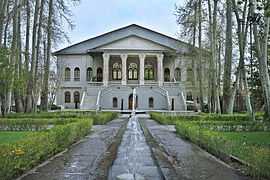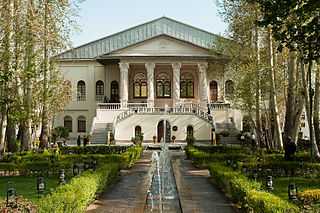Bagh-e Ferdows

Bāgh-e Ferdows (Persian: باغ فردوس), also known as Emārat-e Bāgh-e Ferdows [1] and The Mohammadieh Palace,[2] is a historical palace in Tajrish, Shemiran, North Tehran, between Zafaraniyeh and Jafar Ābād. It is part of a palace complex consisting of two castles, the North Castle and the South Castle, of which the former has decayed.[3] Since 2002, it houses Film Museum of Iran.[4]
The complex was originally designed by Hāji Mirzā Āqāsi, a Sufi believer and the Prime Minister of Mohammad Shah Qajar. It was used as a summer residence by the Qajar family and some nobility. Mohammad Shah Qajar died here in September 1848 and the complex became disused in subsequent years.[5][6]
Evolution
During the reign of the Nasser ad-Din Shah Qajar (1848–1896), the ownership of the compound was transferred to Dust-'Ali Khan Nezām od-Dauleh Mo'ayyer ol-Mamālek, who refurbished the palaces and gave the place the name Ferdows. Later, his son Dust-Mohammad Khan, the son-in-law of Nasser ad-Din Shah, using the workmenship of architects from Esfahan and Yazd, built a new building at the Southern edge of this structure, giving it the name Rashk-e Behesht, meaning "Envy of the Paradise".

Following this, the palace complex changed several hands, until it was bought by Mohammad-Vali Khan, Sepahsālār-e Tonekāboni, also known as Sepahsālār-e A'zam-e Tonekāboni. Mohammad-Vali Khan was the leader of the Constitutionalist Revolutionary Forces from Iran's northern provinvces of Gilan and Mazandaran. He was the first to arrive in Tehran and liberate the city from the Royalist Forces. He became Minister of Defence in the first constitutionalist government that followed dethroning of Mohammad-Ali Shah Qajar in 1909. He subsequently became Prime Minister, holding this post between October 1909 and July 1910.[7][8]
Mohammad-Vali Khan added some further pools and fountains to Bāgh-e Ferdows and regenerated the aqueduct that in earlier years had fed the garden with fresh water. The impressive gate of the garden dates also from this time. The stately mansion was leased to various ministries over the years. In 1937 the Ministry of Education (Vezārat-e Ma'āref) housed a primary and a secondary school, Shapour Schools, in this compound.
After the Iranian Revolution of 1979 until 2002, Bāgh-e Ferdows served as a training centre for film-making. Since 2002, it houses Film Museum of Iran.
Origins of the word Ferdows

The Achaemenid Dynasty built over the entire Persian Empire, especially in Asia Minor, pairi-daēzas, or "paradises", which consisted of extensive Gardens and Parks.
According to OED, as well as Dehkhoda, Xenophon was the first to use the word paradeisos in the meaning of "enclosed park, orchard, or pleasure ground". Dehkhoda writes that the Hebrew word pārdēs entered into this language in the 5th century BC, following the arrival of Jews in Babel, Babylonia. In the sections of the Old Testament that predate this arrival, the notions of "Heaven" and "Hell" are not specific; only later has pārdēs, originally meaning "garden" and "orchard", been endowed with the spiritual meaning that is signified by this word (as well as "paradise") in later times, up to the present date.
Dehkhoda notes that pārdēs has been used synonymously as the Hebrew word gān in the meaning of "Garden of Eden". He continues that the word Ferdows, that has been used twice in Qur'an, has its root in Judaism and Christianity and that the Islamic scholars are generally united in considering that the word Ferdows has been used in Qur'an in the meaning of "garden" and "orchard"; there is, however, no consensus amongst these scholars as to the nature of this place.
Cinema
The Iranian motion picture Bāgh-e Ferdows, 5 O'clock in the afternoon (2005), written, produced and directed by Siamak Shayeghi, with Reza Kianian, Ladan Mostofi and Azita Hajian playing in the principal roles, refers to the public park in front of Bāgh-e Ferdows, from where the main palace is in view.[9]
See also
- Bāgh (term; garden)
- Persian gardens
- Paradise Garden
- Bāgh-e Jinnah (a historical garden)
- Cinema of Iran
References
- ↑ Emārat here means building.
- ↑ Mohammadieh refers to Mohammad Shah Qajar.
- ↑ Loghat'nāmeh-ye Dehkhoda, Third Edition (Tehran University Press, 2006).
- ↑ See the History section in Film Museum of Iran.
- ↑ Sadeq Dehqan, A Glorious Complex: Bagh-e Ferdows, Iran Daily, Arts & Culture, Thursday 20 July 2006, .
- ↑ Khodadad, Mohammadieh Palace, Bagh-e Ferdows, Picasa Web Albums.
- ↑ For the time being see: Haj Ali-Gholi Khan, Sardar Asad II.
- ↑ Amin ol-Molk is the honorific title of Pāshā Khan. Sadeq Dehqan's reference in Iran Daily, loc. cit., to "Aminol Malek" (i.e. Amin ol-Mālek) seems incorrect. For Details consult: Dowlatshahi-Qajar; Shajareh'nameh Project in 1897.
- ↑ 'Sean Penn in Iran, San Francisco Chronicle, 2005: August 22: Day One, August 23: Day Two, August 24: Day Three, August 25: Day Four, August 26: Day Five.
External links
- Film Museum of Iran LINKS: Home, History, Museum Exhibitions.
- flickr; Bāgh-e Ferdows:
- Sean Penn Visits Film Museum in Tehran'
- Unpublished manuscripts of Beizaii on display at Film Museum.
- Hamid-Reza Hosseini, Salutation, Film Museum 'Film Museum of Iran exhibition,in Persian.
- Slide show of Film Museum of Iran exhibition.
- Film Museum of Iran tour
| ||||||||||||||||||||||||||||||||||